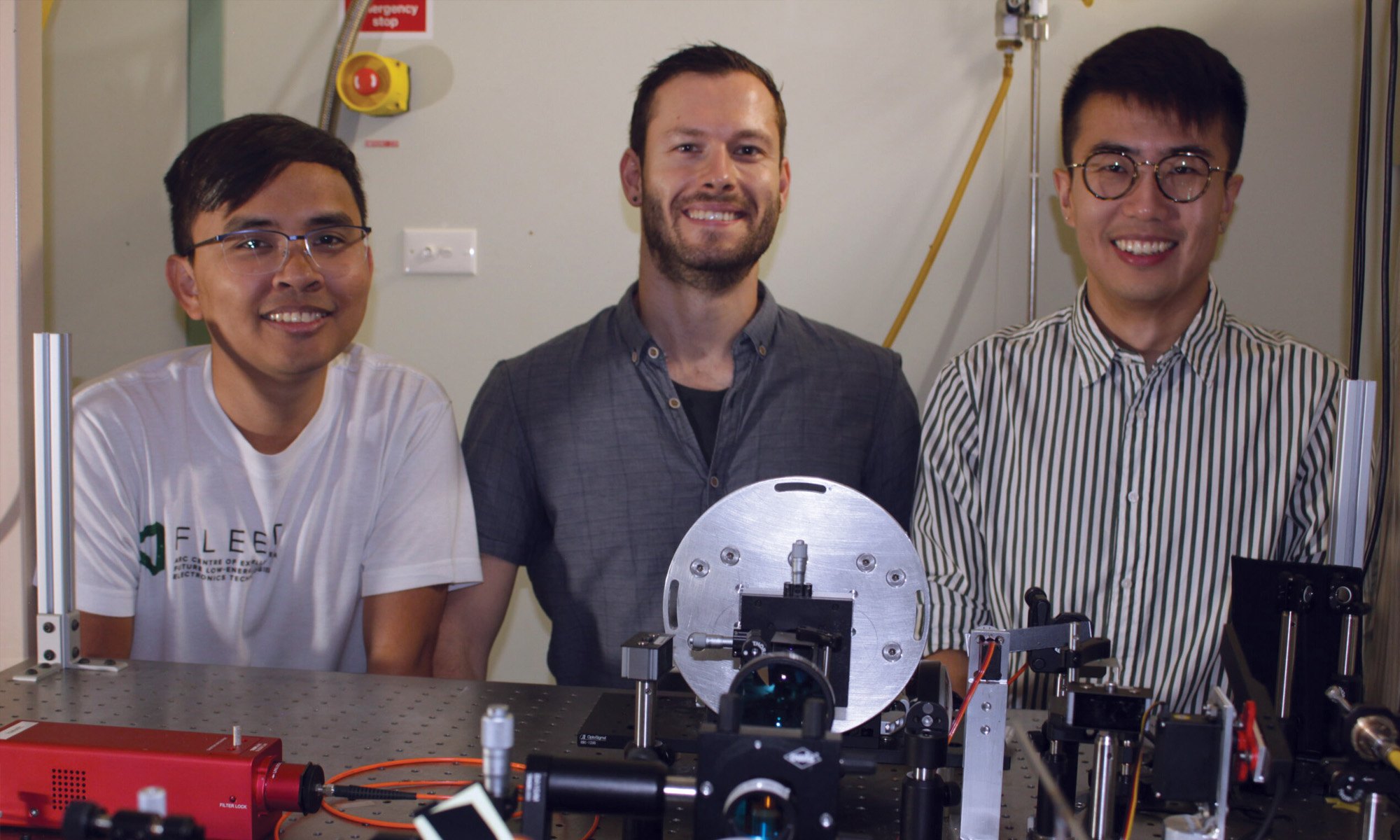Two-dimensional materials have extraordinary properties such as extremely-low resistance or highly-efficient interactions with light. However, they are inherently fragile.
Sandwich-style construction: towards ultra-low-energy exciton electronics
New microcavity construction technique allows observation of robust, room-temperature exciton transport
A new FLEET-led ‘sandwich-style’ fabrication process placing an atomically-thin semiconductor between two mirrors allows a significant step towards ultra-low-energy electronics based on exciton-polariton.
The breakthrough, led by PhD candidate Matthias Wurdack at ANU, demonstrated robust, dissipationless propagation of an exciton mixed with light bouncing between the high-quality mirrors.
Conventional electronics relies on flowing electrons, or holes (a hole is the absence of an electron, i.e. a positively-charged quasi-particle).
Instead, FLEET’s ANU team investigated an alternative future electronic technology using excitons because, in principle, they could flow in a semiconductor without losing energy by forming a collective superfluid state. Also, excitons in novel, actively-studied atomically-thin semiconductors are stable at room temperature.
Despite this promise for low-energy electronics and sensors, the properties of atomically-thin semiconductors, including the flow of excitons, are strongly affected by disorder or imperfections, which can be introduced during fabrication.
The ANU-led FLEET team – with Centre colleagues at Swinburne University of Technology and FLEET Partner institution Wroclaw University – coupled the excitons in an atomically-thin material to light, to demonstrate for the first time their long-range propagation without any dissipation of energy, at room temperature.
Trapping light between two parallel high-quality mirrors in an optical microcavity an exciton (matter) to bind with a photon (light), forming the hybrid particle an exciton-polariton. Microcavities are micrometre-scale structures with an optical medium sandwiched between ultra-reflective mirrors, used to confine light such that it forms exciton-polaritons.
In the 2021 study, a new ‘sandwich-style’ fabrication process for the optical microcavity allowed the researchers to minimise damage to the atomically-thin semiconductor and to maximise the interaction between the excitons and the photons. The exciton-polaritons formed in this structure were able to propagate without energy dissipation across tens of micrometres, the typical scale of an electronic microchip.

Electron-hole pairs in an atomically-thin material (substrate dielectric disorder similar size to excitons), and hybridisation of excitons and photons leading to formation of polaritons, reducing dielectric disorder.
A high-quality optical microcavity ensuring the longevity of the light (photonic) component of exciton-polaritons was the key to these observations. “We found that exciton-polaritons can be made remarkably stable if microcavity construction avoids damage of the fragile semiconductor sandwiched between the mirrors during fabrication,” says Matthias.
“The choice of the atomically-thin material in which the excitons travel is far less important than the construction.”
“We fabricate the entire top structure separately, and then place it on top of the semiconductor mechanically, like making a sandwich. Thus we avoid any damage to the atomically-thin semiconductor, and preserve the properties of its excitons.”
The researchers optimised this sandwiching method to make the cavity very short, maximising the exciton-photon interaction.

FLEET ANU researchers: from left Research Fellow Dr Eliezer Estrecho, PhD student Matthias Wurdack, PhD student Tinghe Yun (Credit: Phil Dooley ANU)
“This demonstration, for the first time, of dissipationless transport of room-temperature polaritons in atomically-thin TMDCs is a significant step towards future, ultra-low-energy exciton-based electronics,” says group leader Prof Elena Ostrovskaya (ANU).
Furthermore, the researchers confirmed that exciton-polaritons can propagate in the atomically-thin semiconductor for tens of micrometres (easily far enough for functional electronics) without scattering on material defects. (In fact, the travel length of excitons in these materials is dramatically reduced by these defects.) The exciton-polaritons’ high coherence bodes well for their potential as information carriers.
“This long-range, coherent transport was achieved at room temperature, which is important for development of practical applications of atomically-thin semiconductors,” said Matthias.
If future excitonic devices are to be a viable, low-energy alternative to conventional electronic devices, they must be able to operate at room temperature, without the need for energy-intensive cooling.
This research relates to FLEET milestones M2.2.1 and M2.2.4.
See page 17 of the strategic plan.
The study was published in Nature Communications in September 2021 (See publications).

This demonstration is a significant step towards future, ultra-low-energy exciton-based electronics.
Prof Elena Ostrovskaya (ANU) Co-author FLEET Chief Investigator
Collaborating FLEET personnel
PhD student
Matthias Wurdack
Australian National University

Research Fellow
Eliezer Estrecho
Australian National University

PhD student
Tinghe Yun
Monash University

Research Fellow
Maciej Pieczarka
Australian National University (Alum)

Research Fellow
Stuart Earl
Swinburne University of Technology

Chief Investigator
Jeff Davis
Swinburne University of Technology

Chief Investigator
Elena Ostrovskaya
Australian National University
